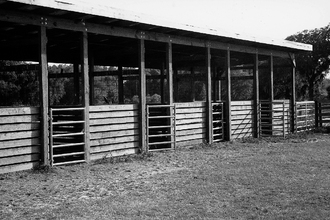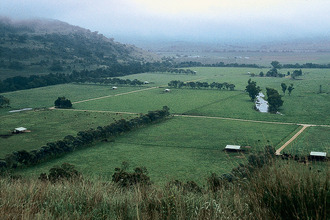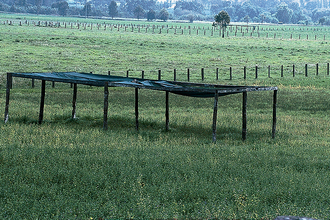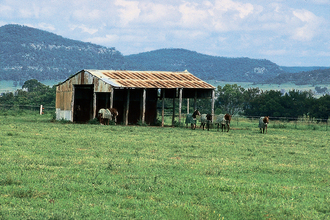Chapter 1 Although many breeders assert that a very good horse can only be bred in a few places in the world, horses are extremely adaptable and reproduce successfully in almost all regions and climates. In general, horses do well in both cold and hot climates. They tolerate high altitudes and deserts, flatlands and mountainous terrain. Furthermore, they reproduce in feral bands with no management at all in some countries. It is unrealistic, therefore, to provide breeders with definitive directions for farm facilities, layouts and fencing that are suitable for any location. Moreover, it is probably too simplistic to prescribe definitive plans for the development of stud farms because there are so many possible variations. The basic concepts will apply in the majority of areas, and local information on building materials and methods will be utilized in the adaptation of these to local conditions. Also, it is recognized that ingenuity applied to management may be more important than defined structures that conform to accepted standards.1 Use of good proven designs from existing facilities can often eliminate mistakes. The general outlines in this chapter apply to all horse-breeding areas in the world. Most countries have their own unique methods of handling, holding, feeding and rearing horses. However, there are many principles that can provide ideas for additional improvement and which may enhance the quality of the environment for horses. Traditional approaches to housing mares and stallions were for two independent sets of quarters, isolated from each other to minimize excitement. However, recent equine behavioral research suggests that integrating stallions and mares in common facilities may have important benefits for the operation.2 The so-called ‘harem effect’, resulting from interactions of sight and sound, produces a calming effect on both sexes, similar to the behavior of a band of mares running with a stallion. It is believed that both behavior and fertility are positively affected. No specific guidelines for facilities are offered, but the obvious first step is to house a stallion in a barn with mares. Considerations of climate and local conditions are important in designing the farm and can significantly affect the layout. In subtropical regions, for example, housing requirements may be completely different from those in more temperate regions. The need for barn space will be significantly less if horses can remain outside all the time. Separation for feeding can be accomplished with small portable pens, or with simple ‘feeding barns’, which can double as holding spaces for routine examinations or extended day-length lighting systems (Fig. 1.1). Horse farms are based on three types of space: Shade from trees is beneficial in hot climates. However, in many circumstances, particularly if there are feed shortages (i.e. roughage), horses will destroy the trees by eating the bark (Fig. 1.2). Simple trunk protectors may be effective in preventing this. Furthermore, some trees are potentially poisonous. In the UK, many older properties have ancient trees that are very dangerous (e.g. yew, red oak, and laburnum). Fig. 1.2 Boredom and lack of roughage often lead to horses causing severe damage to tree trunks, such as this ring-barked tree in the paddock. A row of trees can be planted as a windbreak outside a fence line (Fig. 1.3) and horses will appreciate the protection they afford in the worst weather conditions. These can be simple constructions of four posts with a shade cloth roof in dry climates (Fig. 1.4), or an iron-roofed, more solid waterproof construction of wooden panels or sheet and brick, in which the feeding and water facilities are placed. The protection afforded by shelters is also helpful where Musca flies and culicoides midges are a problem as these invade darkened shade areas less frequently than open-air paddocks with no cover. Where prevailing winter winds are severe, shelters also provide protection from inclement weather. Old hay-storage sheds are often converted into low-cost shelters against, heat, cold and wet conditions (Fig. 1.5). Consideration should be given to access to the farm by the services that will be required. Delivery of construction materials, maintenance needs, service personnel and eventually transportation of animals and foodstuffs require decent hard-surfaced roads with reasonable access to the farm for suitable vehicles. In the UK, small country lanes can be a serious limitation for modern transporters, but by compensation they afford some sense of security. Careful planning of access roads, which should be kept wide enough for vehicles capable of moving horses (particularly mares, foals and young horses) is very important to allow ease of access to all points of the farm. Roads can be used to separate paddocks and so may act as effective quarantine barriers in case of disease outbreaks. They also allow planting of shade trees and installation of water conduits without having to interfere with the fields themselves. Free movement of feed vehicles and farm machinery, and the transfer of mares/foals to other locations on the farm without entry to other occupied paddocks, are also important advantages of a carefully planned road structure. • Will stallions be standing at the stud with their own ‘book’ of mares or will they simply be used for artificial insemination? • If stallions are to be used, how many will be kept and what is their expected ‘book’? • Will outside mares be brought in for breeding and, if so, how many and over what period? • Will mares be visiting the stud to foal in order to get better supervision and foal care and to maximize the use of the foal heat? • Will there be permanently resident mares on the farm and will these take precedence over visiting mares? • Will weanling foals and yearlings be held on the premises? If so, will they be in contact with other outside horses or will they be kept segregated? • Will a high level of veterinary attention be expected (will a veterinarian live on the farm?) or will this be more casual? • Should there be isolation facilities for new animals? This is a very important aspect, and should be discussed in careful detail with the consulting veterinarian. • How long will mares (with or without foals at foot) remain on the stud after covering? • The breeding unit might contain mare and stallion housing, a breeding area, mare examination stocks/chute, laboratory, loading and unloading facilities, feed and hay storage and equipment sheds. • An isolation facility for new arrivals should be located so that farm traffic will not cross-contaminate other portions of the farm (a separate drug-treatment area should be kept and made secure). • A separate, self-contained unit is indicated for weaning and for longer-term housing of weanlings. Weaning is a stressful event for both mares and foals and injuries are commonplace even when facilities are ideal. A survey of fence-related injuries3 supported the contention that no fence is horse-proof and free of potential hazard. The survey pointed out that the highest rate of serious injury occurred with barbed wire fencing, followed by high-tensile steel wire and page wire. Wooden fences (post and rail, and post and board) had high rates of injury, but those injuries were less severe than those related to wire. Although these results are not surprising, the fact that barbed wire fencing on metal posts is the most economical in terms of both materials and installation means that these fences will probably not disappear.
DESIGN AND CONSTRUCTION OF A BREEDING FARM
FEATURES OF SUCCESSFUL FARM DESIGN
SITE SELECTION
Trees and natural shelter
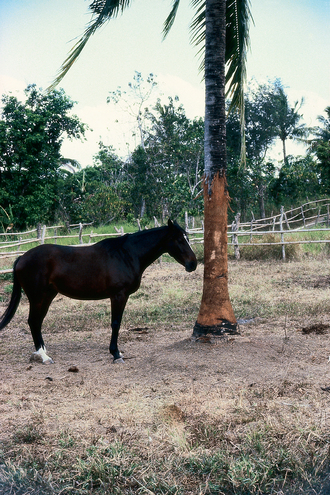
Shade houses/field shelters
ROADS AND ACCESS
Farm layout
FENCING
![]()
Stay updated, free articles. Join our Telegram channel

Full access? Get Clinical Tree


Veterian Key
Fastest Veterinary Medicine Insight Engine

